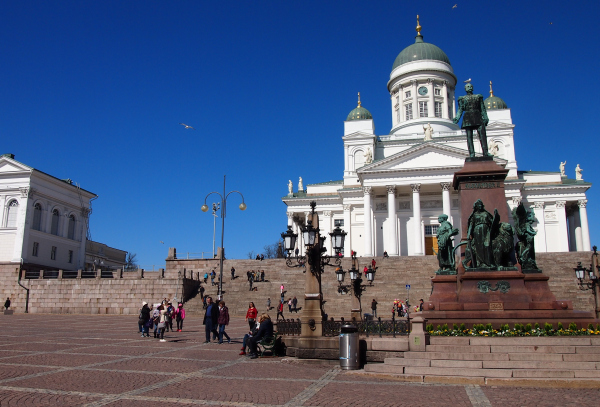Author: Juhana Harju
High levels of wireless radiation in Helsinki
Published May 6, 2019
Helsinki has become a popular tourist destination as many travelers look for alternatives to the more crowded destinations. However, if you are looking for a relaxing holiday, Helsinki might not be the best choice.
The reason is perhaps unexpected. Helsinki has very high levels of wireless radiation because there has not been any attempt to regulate the wireless radiation of mobile phone base stations or Wi-Fi hotspots. Lack of regulation has resulted in very high levels of wireless radiation in public places such as squares, streets, metro and railway stations.

The Senate Square has a high level of radiofrequency radiation.
As proof of the lax regulations, Finland recently received an award from the GSMA, the international body of mobile operators. The award shows that the wireless industry is very pleased with the policy Finland has adopted as it gives the operators a free license to develop wireless technology applications, in my opinion recklessly, without any need to regulate exposure levels of wireless transmitters.
Among the Finnish officials and leading politicians, there has not been any consideration that radiofrequency radiation is a health hazard to the general population and especially to the most vulnerable population groups, such as children, the elderly, the infirm and those with electromagnetic hypersensitivity.
Mobile phone base stations and Wi-Fi routers radiate radiofrequency radiation in the microwave range. The exposure levels in major Finnish cities – Helsinki, Tampere and Turku – are often higher than those measured in the recent case studies in Stockholm.
In those case studies it was found that radiofrequency radiation was high in the Stockholm Old Town and at the railway station in Stockholm (Hardell 2016, Hardell 2017).
Helsinki Senate Square is a popular tourist spot famous for its Empire style architecture and Helsinki Cathedral. Unfortunately, the radiofrequency radiation levels are high at this location. The average radiofrequency level at the center of the square is approximately 45 000 μW/m2, and the highest exposure level was 131 000 μW/m2 at the time of the measurement.
Some of the readers may ask themselves: aren’t there any safety limits of radiofrequency radiation in Finland? Yes, there are. Finland follows the regulatory guidelines by ICNIRP, which is a non-governmental organization infamous for its ties with the mobile industry and membership by invitation only.
ICNIRP’s guidelines are designed to protect only from short-term thermal effects and do not protect against non-thermal long-term effects of low-intensity radiofrequency radiation. Today it is well-established by science that radiofrequency radiation has detrimental biological and health effects that occur well below the obsolete ICNIRP guidelines (Belpomme 2018).
Unfortunately, the regulatory bodies, including the Finnish Radiation Safety Authority (STUK), appear to be in denial by conforming to the interests of mobile industry and failing to implement the precautionary principle.
On the basis of the above I would not recommend Helsinki as a tourist destination. The wireless radiation levels are much lower in many other European cities. Italy and Switzerland, among some others, are countries that have much lower exposure levels than Finland. These are more environmentally friendly tourist destinations to visit than the electrosmog polluted Helsinki.
The wireless radiation exposure is expected to rise even further in Helsinki once 5G becomes fully implemented, since the new technology necessitates a dense network of small-cell mobile phone base stations.
References:
Belpomme D, et al. Thermal and non-thermal health effects of low intensity non-ionizing radiation: An international perspective. Environ Pollut. 2018 Nov;242(Pt A):643-658.
Belyaev I, et al. EUROPAEM EMF Guideline 2016 for the prevention, diagnosis and treatment of EMF-related health problems and illnesses. Rev Environ Health. 2016 Sep 1;31(3):363-97.
Falcioni L, et al. Report of final results regarding brain and heart tumors in Sprague-Dawley rats exposed from prenatal life until natural death to mobile phone radiofrequency field representative of a 1.8 GHz GSM base station environmental emission. Environ Res. 2018 Aug;165:496-503.
Finland given an important recognition for forward-looking communications policy. Ministry of Transport and Communications. Press Release 26.02.2019.
Hardell L, et al. High radiofrequency radiation at Stockholm Old Town: An exposimeter study including the Royal Castle, Supreme Court, three major squares and the Swedish Parliament. Mol Clin Oncol. 2017 Apr;6(4):462-476.
Hardell L, et al. Radiofrequency radiation at Stockholm Central Railway Station in Sweden and some medical aspects on public exposure to RF fields. Int J Oncol. 2016 Oct;49(4):1315-1324.
Hardell L. World Health Organization, radiofrequency radiation and health – a hard nut to crack (Review). Int J Oncol. 2017 Aug;51(2):405-413.
Miller AB, et al. Cancer epidemiology update, following the 2011 IARC evaluation of radiofrequency electromagnetic fields (Monograph 102). Environ Res. 2018 Nov;167:673-683.
